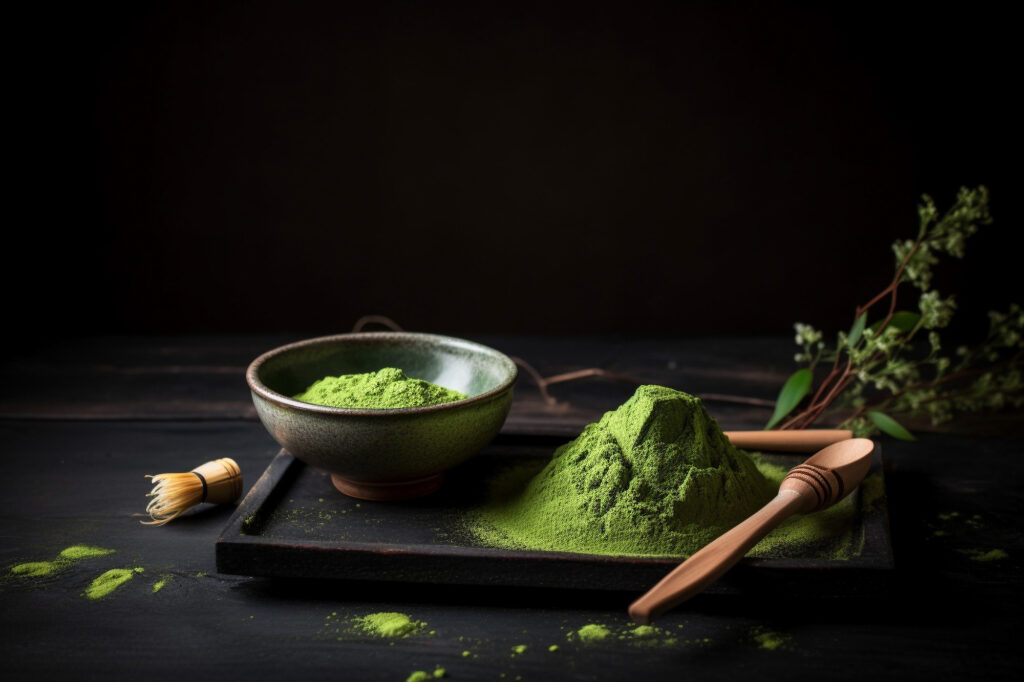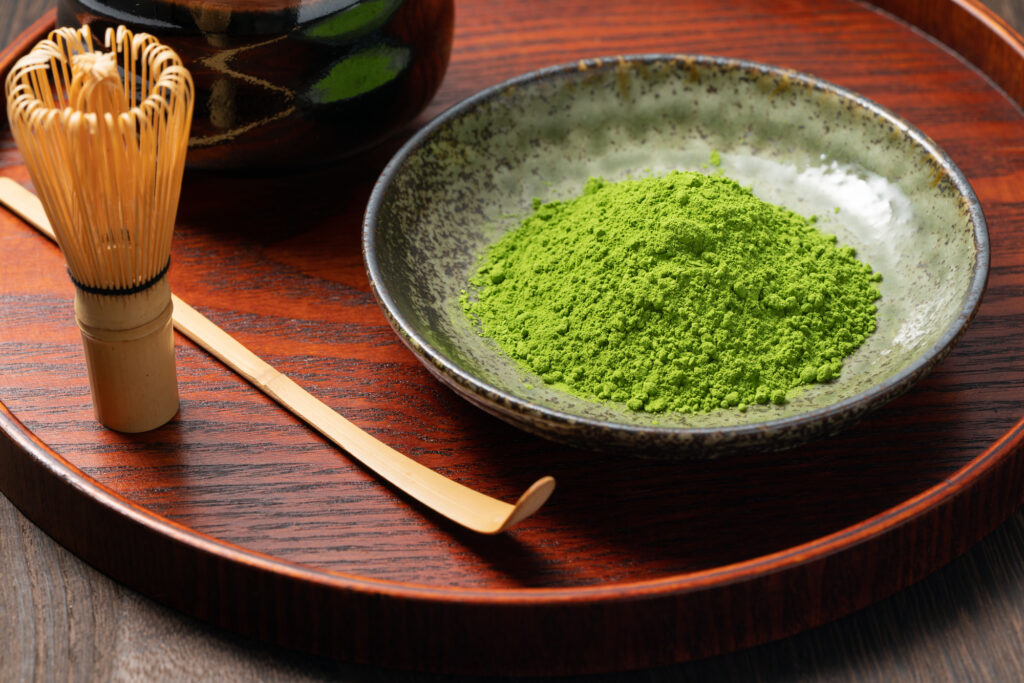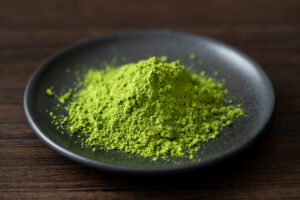Basics of Matcha Pound Cake and How to Select High-Quality Matcha
Creating the perfect matcha pound cake begins with selecting high-quality matcha. This first step is particularly important as the flavor and color of the matcha will greatly influence the final result of your cake. The complex umami and balanced bitterness of matcha gives depth to the pound cake and creates a vibrant green color.
Matcha Grades Suitable for Pound Cake

Matcha primarily comes in “Usuicha” (thin tea) and “Koicha” (thick tea) grades, with “cooking grade” matcha also available commercially. Here are recommendations for pound cake:
- Cooking Grade Matcha: Readily available in supermarkets and can make a tasty cake, but may result in a lighter color and somewhat lacking flavor.
- Usuicha (Thin Tea): A medium-grade matcha with well-balanced flavor and color, ideal for pound cakes.
- Koicha (Thick Tea): The highest grade with rich flavor, but more expensive. Recommended for special occasions or when seeking professional-quality results.
According to the Japanese Tea Instructor Association, medium to high-quality “Usuicha” grade matcha is most suitable for baking. This is because it has a good balance of bitterness and sweetness, and maintains its vibrant color even after baking.
Key Points for Selecting Matcha Without Fail
- Color: Choose matcha with a vibrant green color. Those with brown or yellowish tints may be stale.
- Aroma: Fresh matcha has a refreshing scent. Avoid those with weak aroma.
- Fineness of Particles: High-quality matcha is extremely fine powder and feels smooth when rubbed between fingers.
- Origin: Matcha from traditional tea regions such as Uji in Kyoto, Shizuoka, or Yame in Fukuoka offers consistent quality.
When making matcha pound cake, even if labeled for confectionery use, some products may have pale color and weak aroma. If possible, it’s recommended to choose medium or higher grade “Usuicha” matcha sold at specialty tea shops. Price ranges from about 500 to 1,000 yen per 10g. This investment will be the key to significantly enhancing the flavor and appearance of your matcha pound cake.
Foolproof Matcha Pound Cake Recipe – Secrets of Ingredients and Proportions
The key to making a successful matcha pound cake lies in ingredient selection and proportion balance. Here are tips for maximizing matcha flavor while achieving a moist texture.
Basic Ingredients and Measurements (for one 18cm pound cake)
- Cake flour: 120g
- High-quality matcha powder: 10g (confectionery grade, medium to high quality)
- Unsalted butter: 100g (brought to room temperature)
- Granulated sugar: 80g
- Eggs: 2 (M to L size, brought to room temperature)
- Baking powder: 1/2 teaspoon
- Milk: 1 tablespoon
- White bean paste or matcha white chocolate: 50g (optional)
Tips for Choosing Matcha
The color and aroma are essential for matcha used in pound cakes. While inexpensive “cooking matcha” can be used, “confectionery matcha” or “drinking matcha” is recommended for authentic flavor. Choosing medium-grade or higher matcha from Uji in Kyoto or Shizuoka will provide a vibrant green color and lasting deep aroma. According to a 2020 survey by the Japan Tea Central Association, there is approximately a 30% difference in color retention after baking between confectionery matcha and drinking matcha.
Secrets to Prevent Failure in Proportions

The main causes of failure in matcha pound cakes are “powderiness” and “astringency.” To prevent these:
- Pre-sift matcha and cake flour: Matcha tends to clump, so sifting it together with cake flour 2-3 times ensures even mixing without lumps.
- Creaming butter and sugar: Mix until whitish to achieve a fine texture. Using a hand mixer for 3-5 minutes is recommended.
- Add eggs in small amounts: Adding all at once can cause separation. Add in 3-4 portions.
- Role of milk: Softens the astringency of matcha and increases moisture. If using more matcha, increase to 1.5 tablespoons.
The “prevention of over-mixing” practiced by professional pastry chefs is also important. Mix by cutting through the batter with a rubber spatula, and stop as soon as the powder disappears. Excessive mixing develops gluten, causing a hard cake.
With proper temperature management of ingredients and correct mixing techniques, you can create an authentic Japanese sweet at home. The next section will cover specific preparation methods using these ingredients.
Mixing Techniques and Baking Tips to Maximize Matcha Flavor
The key to bringing out the maximum flavor of matcha lies in how you mix the batter and manage the baking temperature. Here are detailed points for successfully completing your matcha pound cake.
Basic Mixing Techniques for Matcha Pound Cake
The essence of matcha pound cake lies in its vibrant green color and aromatic flavor. To preserve these characteristics, mixing technique is crucial. First, mixing butter and sugar until whitish creates a fine texture in the cake. Spending about 3-5 minutes on this process incorporates sufficient air, resulting in a light and fluffy texture.
When adding matcha, always sift it together with the dry ingredients (such as flour). Research shows that matcha is susceptible to moisture and can coagulate, losing flavor when added directly to liquids. Sifting ensures even distribution of matcha particles, preserving its beautiful green color and aroma.
Techniques to Avoid Over-mixing

The most important point to be careful about in matcha pound cake is “over-mixing.” Excessive mixing after adding flour promotes gluten development, causing the cake to become hard. Especially with matcha cakes, to preserve their delicate flavor, remember to “cut through the batter” or “gently scoop up from the bottom with a rubber spatula” after adding flour.
According to professional pastry chefs, the ideal number of mixing strokes is about 15-20 times. This is sufficient for the flour to disappear. Batter temperature is also important, with research showing that maintaining 20-22°C best enhances matcha aroma.
Managing Baking Temperature and Time
Temperature management is essential to preserve matcha flavor and color. High temperatures can turn matcha brown and damage its flavor. The ideal baking temperature is 170°C, with thorough preheating and slow baking for 45-50 minutes being key points.
To determine when baking is complete, insert a bamboo skewer – it’s done when no batter sticks to it. However, for matcha pound cake, leaving a slight moistness (where a small amount of batter sticks) creates a moister texture. Letting the cake mature in the pan for 15 minutes after baking further enhances the matcha aroma.
By implementing these techniques, you can create a matcha pound cake that maximizes the flavor and color of matcha without failure.
Matcha Pound Cake Variations – Exquisite Fusion of Japanese and Western Styles
Japanese-Style Matcha Pound Cake with Sweet Bean Paste

Once you’ve mastered the basic matcha pound cake, try incorporating Japanese ingredients for creative variations. The most popular is “matcha pound cake with sweet bean paste.” Either mix chunky red bean paste made from Hokkaido azuki beans into the batter or create a layer of sweet bean paste in the center. This creates an exquisite harmony between the bitterness of matcha and the sweetness of bean paste.
According to a 2022 survey by the Japan Confectionery Association, the “matcha and sweet bean paste” combination boasts an overwhelming 75% approval rating among matcha sweets. Additionally, adding ingredients like shiratama mochi, chestnuts, or black sesame can further emphasize Japanese flavors.
Western-Style Variations Expanding the World of Matcha Pound Cake
Matcha also pairs excellently with Western ingredients. Here are three particularly popular variations:
- Matcha White Chocolate Pound Cake: Chopped white chocolate mixed into the batter creates a perfect balance between matcha’s astringency and chocolate’s sweetness.
- Matcha Cream Cheese Pound Cake: Adding cream cheese creates a moist texture and rich taste.
- Matcha Orange Pound Cake: Adding orange peel or juice enhances matcha flavor with refreshing citrus notes.
Seasonal Matcha Pound Cakes
Incorporating seasonal ingredients allows you to enjoy different matcha pound cake versions throughout the year. For spring, salted cherry blossoms and white chocolate; for summer, berries like blueberries and raspberries; for autumn, chestnuts and persimmons; for winter, cinnamon and dried fruits are recommended.
According to a survey supervised by pastry chefs, “seasonal matcha pound cakes” receive particularly high support from women in their 20s to 40s, with social media posts about 2.3 times higher than regular matcha cakes.
Once you master the basic matcha pound cake batter, endless variations are possible according to your preferences and the season. Find your favorite combination!
Professional Tips! Storage Methods, Beautiful Presentation, and Ways to Enjoy Matcha Pound Cake
Optimal Storage Methods to Preserve Flavor

Proper storage methods are essential to enjoy the flavor and texture of your carefully made matcha pound cake for longer. Matcha is prone to oxidation, so storage methods significantly affect how long the flavor lasts. At room temperature, it stays fresh for 2-3 days; in the refrigerator, about one week; and frozen, it can be preserved deliciously for about a month.
When storing, the key is to wrap each slice individually before placing in an airtight container. For freezing, wrapping in kitchen paper before plastic wrap prevents stickiness from moisture during thawing. Natural thawing is basic, but slight warming restores moistness.
Beautiful Plating Techniques for Matcha Pound Cake
The presentation of matcha pound cake greatly affects the impression of its taste. For a traditional Japanese taste, simply placing the matcha pound cake on a white Japanese plate with seasonal flowers or leaves dramatically improves its appearance.
Professional plating tips include:
- Lightly dusting powdered sugar or matcha powder with a chasen (tea whisk) to create a snow-like scenic effect
- Adding sweet bean paste or whipped cream for a fusion of Japanese and Western flavors
- Topping with black honey (kuromitsu) or kinako (roasted soybean flour) to add Japanese essence
Diverse Ways to Enjoy Matcha Pound Cake
Matcha pound cake can be enjoyed with various arrangements. According to the Japan Tea Research Institute, the number of people enjoying matcha sweets paired with tea has increased by about 40% over the past five years.
Especially recommended is pairing with hojicha (roasted green tea). The refreshing bitterness of matcha and the toasty flavor of hojicha create an exquisite harmony. Adding vanilla ice cream transforms it into a dish where you can enjoy the contrast between warm cake and cold ice cream.
Matcha pound cake is perfect not only as a tea accompaniment but also for breakfast or brunch. Slice it about 1cm thick, toast it, and drizzle with honey to enjoy a different taste with enhanced aroma. Fully appreciate the profound flavor of matcha.
ピックアップ記事





Comments